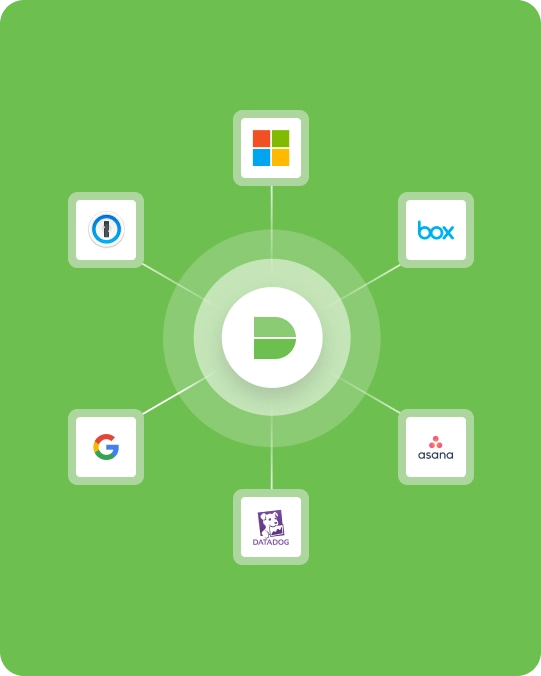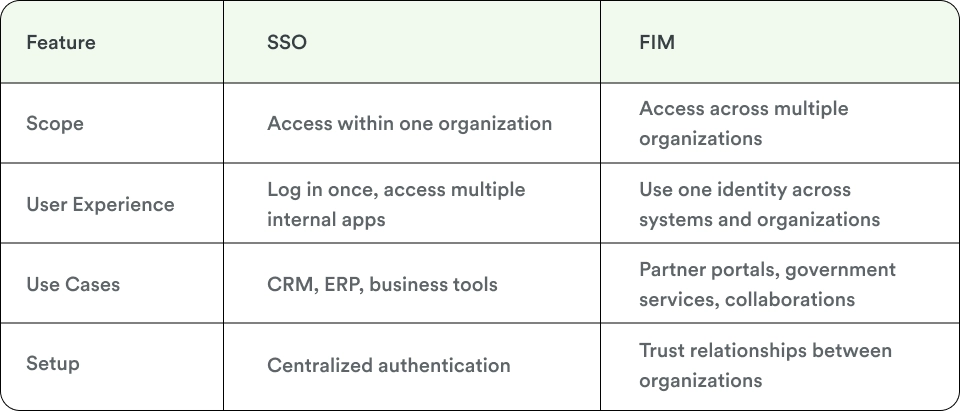Federated identity management vs SSO: What you need to know
Whether your organization needs to give users easier access to internal apps or enable secure connections for IT teams and partners, SSO and federated identity management (FIM) can help. This guide from Cisco Duo outlines the key differences—and how to choose the right approach to keep work flowing securely.
Key takeaways
Use single sign-on (SSO) to reduce login friction and give users fast, secure access to all their internal apps with just one sign-in.
Implement federated identity management (FIM) to let users access trusted external systems using a single, verified identity—no new credentials are required.
Evaluate your access needs—internal, external, or both—to choose the right solution. For many organizations, combining SSO and FIM offers the best balance of usability and security.

Why choosing the right access solution matters
Imagine your team is in the zone—collaborating across systems, closing deals, or accessing critical partner platforms—when, suddenly, a login roadblock brings everything to a halt. Multiply that friction across departments and tools, and you’ve got a daily disruption that drains productivity and frustrates users.
Choosing the right access solution becomes essential for minimizing these interruptions and keeping business moving smoothly.
But what solution will work best for your organization’s needs?
Single sign-on (SSO) streamlines your internal access so you can sign in once and move freely within your organization. Meanwhile, federated identity management (FIM) lets you cross organizational boundaries using one identity for trusted partner systems.
For a growing organization with limited IT support, the right identity strategy can increase efficiency, reduce support burdens, and strengthen security. This guide explores how each option works, what they offer, and when combining both can deliver the most value.
Want to stay ahead of what’s next in identity security? Check out the top 3 identity security trends shaping 2025.
What is SSO, and how does it help manage access?
SSO is the go-to for simplifying internal access. It lets users log in once and move between apps without re-entering credentials—cutting down on friction and boosting day-to-day efficiency.
How single sign-on (SSO) works
Single sign-on (SSO) lets users log in once and gain access to multiple connected systems within a single domain using that one set of credentials.
SSO relies on trusted protocols like Security Assertion Markup Language (SAML) and OpenID Connect (OIDC) to securely share authentication details between your identity provider and each app or service.
Think of SAML as a digital handshake—your identity provider uses it to vouch for you when you log in—while OIDC, built on the OAuth 2.0 framework, offers a modern, flexible way to confirm your identity. Together, they ensure your credentials are passed safely and seamlessly so you can access your apps with a single sign-on.
Why SSO improves productivity and security
Instead of remembering a dozen passwords for tools like your customer relationship management (CRM) platform, email account, and HR portal, employees log in once, usually at the start of their day, and can move between approved apps without re-authenticating.
SSO helps end users and IT teams by:
Simplifying sign-in routines
Cutting down on IT support requests
Streamlining onboarding and offboarding
Minimizing the risk of reused or weak credentials
SSO risks and how to manage them
SSO is a powerful tool for simplifying access. It allows users to sign in once and move between applications without re-entering credentials, reducing friction and improving productivity. But like any access solution, it comes with a few important considerations.
Here's what to watch for:
Single point of failure
If the identity provider goes down or is breached, access to all connected apps may be affected.
Session hijacking
Depending on the implementation, attackers might be able to hijack an active session and gain access without needing to reauthenticate.
MFA fatigue
Repeated MFA prompts may lead users to approve requests without scrutiny, raising phishing and push notification attack risks.

What is federated identity management?
When access needs to cross organizational lines, FIM makes the connection. It enables secure authentication between trusted entities without new credentials or logins.
How federated identity management (FIM) works
Federated identity management (FIM) allows identity assertions to be shared across distinct domains, enabling users to access trusted external services without creating new credentials. It works by building trust between your identity provider and external systems, so once you're verified, those systems accept your credentials without extra logins.
FIM uses federation protocols like SAML and OIDC—as well as WS-Federation for older systems. Think of WS-Federation as an older federation protocol primarily used with Microsoft environments, ensuring that even if different platforms speak different languages, they can all understand and trust your verified identity.
Why federated identity management (FIM) matters
With FIM, users log in to one system—like their employer’s network—to securely access services or tools managed by another trusted party on a separate domain.
Common FIM use cases include:
Public-sector portals that serve users across agencies
Academic or research institutions sharing tools
Businesses working closely with external vendors or clients
Security considerations for FIM implementation
Federated identity management opens doors across organizations, but with that flexibility comes added complexity. Like any cross-domain solution, it needs careful setup and oversight to avoid unintended risks.
Key challenges to keep in mind:
Misconfigured trust relationships
If settings are wrong, someone might get access they shouldn’t, which can lead to security problems.
Compatibility issues
When systems don't work well together, it can cause breakdowns in communication or security.
Compliance challenges
Different rules in different countries and in different vertical industries can make it tricky to manage data correctly.
Comparing federated identity management vs SSO
SSO and FIM both reduce password fatigue and improve user access, but they solve different challenges. Understanding how they compare can help you decide which solution—or combination—best supports your organization.
When comparing federated identity management vs SSO, it all comes down to scope.

You might think of SSO as your key to the building, while FIM is your passport to trusted places outside of it.
How to choose between SSO, FIM, or both
When login issues disrupt your workflow, it’s time to choose the identity solution that keeps your organization running smoothly. Whether you need smooth internal access, reliable cross-domain connectivity, or a blend of both, here’s your playbook:
Choose SSO to streamline internal access
For efficient internal operations, single sign-on (SSO) lets users log in once to access multiple enterprise apps—reducing password fatigue and the risk of weak credentials. While SSO simplifies access, it also introduces risks like a single point of failure, session hijacking, and MFA fatigue.
Use FIM for secure access across multiple organizations
When your operations extend beyond your organization, Federated Identity Management (FIM) steps in. FIM allows a single identity to work across multiple domains—ideal for business partners, public-sector portals, or academic collaborations. It consolidates authentication using protocols like SAML, OpenID Connect, and WS-Federation, though it requires careful management to avoid trust misconfigurations and compatibility issues.
Combine SSO and FIM for flexible identity management
For many organizations, the winning strategy is blending both. Combine SSO’s frictionless internal access with FIM’s secure, cross-domain capabilities to maintain smooth workflows and robust security. With Cisco Duo seamlessly integrating both, you create a fortified, zero trust environment that keeps your IT and security teams agile and secure.
No matter which option you choose—SSO for streamlined internal access, FIM for secure external collaboration, or both—the goal remains the same: give your users secure, seamless access that keeps work moving in today’s fast-paced digital world.
Why identity security platforms like Duo matter
In today's digital environment, seamless and secure access is your winning strategy. Whether you're leveraging SSO for streamlined entry, FIM for smooth cross-organization connections, or a combo of both, the right identity security platform makes all the difference.
These solutions help you cut through the clutter by:
Adapting on the fly
Delivering Duo Risk-Based Authentication that adjusts in real time based on each login’s context and risk level.
Playing by trusted rules
Giving support for open standards like SAML, OpenID Connect, and WS-Federation for smooth integration.
Scaling security
Providing risk-based controls that tailor protection to every access attempt.
Keeping score
Giving you full visibility into who’s accessing what—from every device and session.
How Duo supports SSO, FIM, and zero trust security
When you choose Duo, you're not just getting basic login protection—you're powering up with a full defense strategy that supports SSO, FIM, or both. Duo helps your IT and security teams manage access efficiently and protect critical systems:
Seamless integration
Duo works with your existing identity providers to deliver secure, frictionless access for both internal apps and trusted external systems.
Adaptive MFA
Whether defending your internal fortress or extending your reach to partner domains, Duo’s dynamic MFA protects every login attempt.
Risk-based access
Smart, context-aware controls adjust security measures based on the threat level of each access.
Zero trust ready
Designed for a zero trust environment, Duo secures every user, device, and session—without slowing your end users down.
Ready to experience next-level security?
Start your free Duo trial today and see how Duo’s security solutions go beyond basic login protection to secure every step of your journey.
Want to learn more about access and identity security?
Discover more ‘what-is’ content and learning resources, including ebooks, guides and webinars, crafted to help you enhance your organization's access security strategy.
